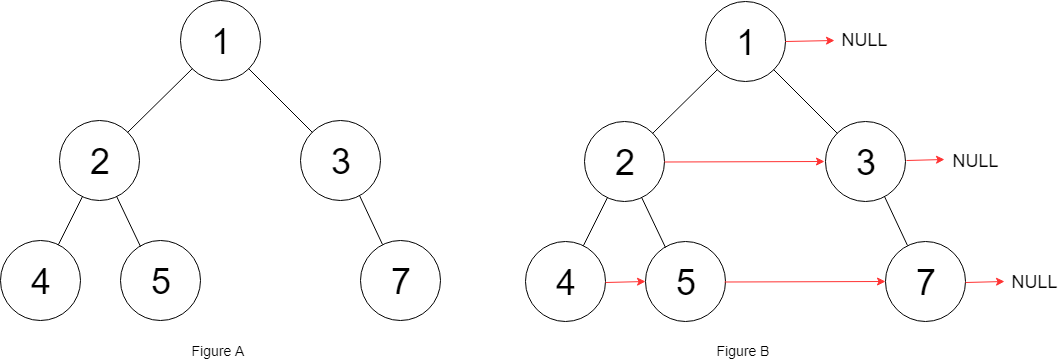题目
给定一个二叉树:
struct Node {
int val;
Node *left;
Node *right;
Node *next;
}1
2
3
4
5
6
2
3
4
5
6
填充它的每个 next 指针,让这个指针指向其下一个右侧节点。如果找不到下一个右侧节点,则将 next 指针设置为 NULL 。
初始状态下,所有 next 指针都被设置为 NULL 。
示例 1:
输入:root = [1,2,3,4,5,null,7]
输出:[1,#,2,3,#,4,5,7,#]
解释:给定二叉树如图 A 所示,你的函数应该填充它的每个 next 指针,以指向其下一个右侧节点,如图 B 所示。序列化输出按层序遍历顺序(由 next 指针连接),'#' 表示每层的末尾。1
2
3
2
3
示例 2:
输入:root = []
输出:[]1
2
2
提示:
- 树中的节点数在范围
[0, 6000]内 -100 <= Node.val <= 100
进阶:
- 你只能使用常量级额外空间。
- 使用递归解题也符合要求,本题中递归程序的隐式栈空间不计入额外空间复杂度。
题解
java
public Node connect(Node root) {
if (root == null || (root.left == null && root.right == null)) {
return root;
}
// 拼接当前节点子节点 得到未拼接next的节点
Node previous;
// 若左右节点都存在 则拼接左右节点 并且待拼接节点为右节点
if (root.left != null && root.right != null) {
root.left.next = root.right;
previous = root.right;
} else {
// 若子节点存在null节点 则待拼接节点为非null那个节点
previous = root.left != null ? root.left : root.right;
}
// 拼接前一节点和后一节点
// next节点存在多个 可能存在next节点无子节点 遍历直到next存在子节点或next为null
// 优先选next的左节点 若左节点为null 选择右节点 若右节点为null 则前一节点没有next
Node next = root.next;
while (next != null && next.left == null && next.right == null) {
next = next.next;
}
if (null != next) {
previous.next = next.left != null ? next.left : next.right;
}
// 递归拼接左右树
// 先拼接右树 再拼接左树
// 保证右树的next节点拼接 再用左节点拼接
this.connect(root.right);
this.connect(root.left);
return root;
}1
2
3
4
5
6
7
8
9
10
11
12
13
14
15
16
17
18
19
20
21
22
23
24
25
26
27
28
29
30
31
32
33
34
35
2
3
4
5
6
7
8
9
10
11
12
13
14
15
16
17
18
19
20
21
22
23
24
25
26
27
28
29
30
31
32
33
34
35